In today’s world, gluten-free and lactose-free recipes are gaining popularity, especially as more people embrace these diets for health reasons. These recipes are for people with celiac disease, gluten sensitivity, or lactose intolerance. Moreover, they also cater to those who want to improve their health with careful eating.
Gluten and lactose are two common components in many traditional recipes; however, they can cause significant discomfort for those who are sensitive to them. Gluten is a protein found in wheat, barley, and rye, while lactose is a sugar present in dairy products. Adopting a gluten-free and lactose-free lifestyle doesn’t mean you have to miss out on flavorful and satisfying meals. In fact, with the right ingredients and techniques, you can create a wide range of dishes that are both nutritious and delightful.
This article explores the essentials of gluten-free and lactose-free cooking, offering a variety of recipes, tips, and strategies to make your culinary journey seamless and enjoyable. From hearty breakfasts to indulgent desserts, we’ll cover it all, ensuring your kitchen becomes a haven for wholesome and allergy-friendly meals.
Understanding Gluten-Free and Lactose-Free
What is Gluten?
Gluten is a group of proteins primarily found in grains like wheat, barley, and rye. Furthermore, it acts as a binding agent in many foods. It acts as a binding agent, giving dough its elasticity and helping baked goods maintain their shape. While gluten is safe for most people, it can, therefore, be problematic for those with celiac disease, gluten sensitivity, or wheat allergies. Consuming gluten in these cases can cause stomach problems, swelling, and other health issues.
What is Lactose?
Lactose is a type of sugar found in milk and dairy products. Consequently, it requires the enzyme lactase for digestion, which some people lack. Without enough lactase, consuming lactose can result in symptoms such as bloating, gas, and diarrhea. This condition, called lactose intolerance, affects many people worldwide.
Who Needs These Diets?
- Celiac Disease Sufferers: These individuals experience an autoimmune reaction to gluten, damaging their small intestine.
- Gluten Sensitivity: People with non-celiac gluten sensitivity may experience similar symptoms without the autoimmune response.
- Lactose Intolerance: Common among adults, this condition makes it difficult to digest dairy products.
- Allergies and Preferences: Some individuals avoid gluten and lactose due to allergies, veganism, or personal wellness choices.
The Benefits of Gluten-Free and Lactose-Free Diets
- Improved Digestion: Eliminating these components can reduce bloating, gas, and stomach discomfort.
- Enhanced Energy Levels: Many report feeling lighter and more energetic when avoiding gluten and lactose.
- Reduced Inflammation: Both gluten and lactose can contribute to inflammation in sensitive individuals, so removing them may improve overall health.
Transitioning to a gluten-free and lactose-free diet can feel overwhelming at first, but with a bit of knowledge and creativity, it’s possible to craft meals that are just as satisfying and diverse as traditional recipes.
Key Ingredients for Gluten-Free Cooking
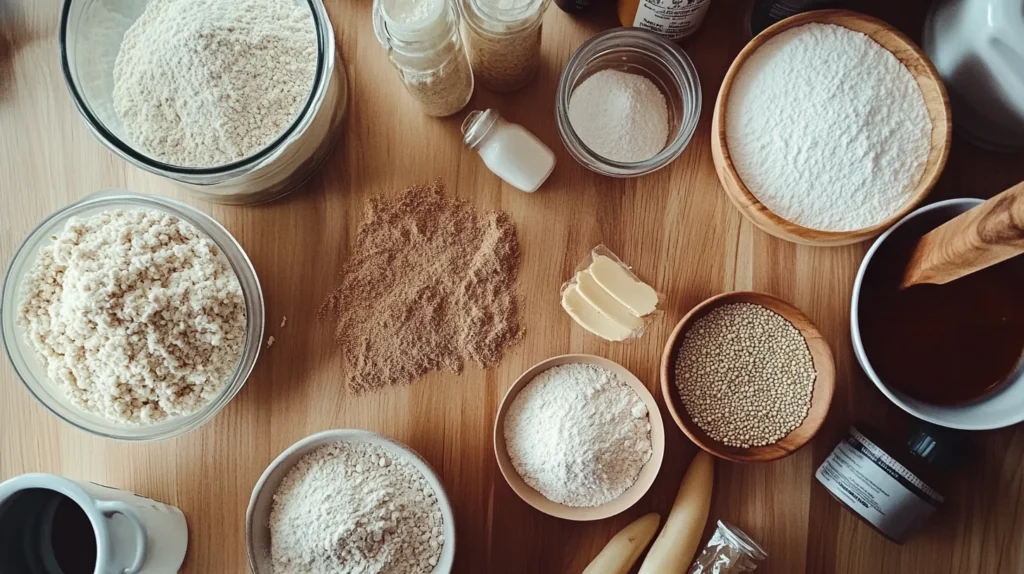
Flour Substitutes
- Almond Flour: Made from ground almonds, this is a great option for baking and savory dishes.
- Coconut Flour: High in fiber and low in carbs, ideal for desserts.
- Rice Flour: A versatile ingredient for baked goods and thickening sauces.
- Tapioca and Arrowroot Flour: Perfect for binding and adding elasticity to dough.
Grain Alternatives
- Quinoa: A protein-rich seed that works well in salads, bowls, or as a rice substitute.
- Millet: A mild-tasting grain suitable for porridge or side dishes.
- Buckwheat: Despite its name, buckwheat is gluten-free and great for pancakes or noodles.
Thickeners and Binders
- Xanthan Gum: A common gluten substitute in baking, adding structure to recipes.
- Psyllium Husk: A fiber-rich ingredient that makes gluten-free bread softer.
Using these alternatives, you can create gluten-free dishes without sacrificing flavor or texture. Additionally, experimenting with combinations of these ingredients can yield even better results. Furthermore, experimenting with combinations of these ingredients can yield even better results. Experimenting with combinations of these ingredients can yield even better results.
Must-Have Ingredients for Lactose-Free Recipes
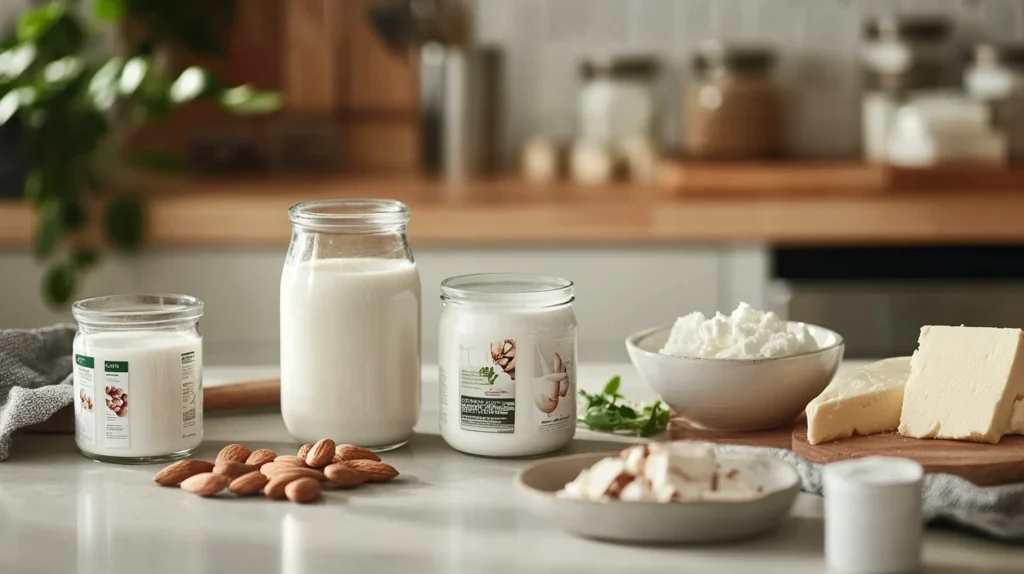
Plant-Based Milk Alternatives
- Almond Milk: A light and nutty substitute suitable for smoothies, baking, and cereals.
- Coconut Milk: Perfect for creamy soups, curries, and desserts.
- Oat Milk: A versatile option with a neutral flavor, great for coffee and sauces.
- Soy Milk: Rich in protein, ideal for cooking and baking.
- Cashew Milk: Creamy and slightly sweet, perfect for dairy-free sauces.
Lactose-Free Dairy Products
- Lactose-Free Cheese: Available in various types like cheddar, mozzarella, and cream cheese.
- Lactose-Free Yogurt: Great for breakfast or as a base for dressings and dips.
- Lactose-Free Butter: Retains the flavor and functionality of traditional butter.
Other Substitutes
- Coconut Cream: A thick and creamy alternative to heavy cream in recipes.
- Nutritional Yeast: Offers a cheesy flavor, making it ideal for sauces and toppings.
- Dairy-Free Ice Creams: Typically made with coconut milk, almond milk, or cashew milk.
These substitutes not only mimic the textures and flavors of dairy but also bring their own unique qualities to recipes, enriching your culinary repertoire.
Gluten-Free and Lactose-Free Breakfast Recipes
Gluten-Free Pancakes
These fluffy pancakes are a delicious way to start your day.
- Ingredients: Almond flour, eggs, almond milk, a pinch of salt, and baking powder.
- Instructions:
- Mix all ingredients in a bowl until smooth.
- Heat a skillet and pour small amounts of batter to form pancakes.
- Flip when bubbles form, then cook until golden brown.
Lactose-Free Chia Seed Pudding
Packed with omega-3s and fiber, this pudding is easy to prepare.
- Ingredients: Chia seeds, coconut milk, maple syrup, and vanilla extract.
- Instructions:
- Combine all ingredients in a jar.
- Let it sit overnight in the refrigerator.
- Serve with fresh fruit and nuts.
Oatmeal Alternatives
For a gluten-free twist, use certified gluten-free oats or substitutes like quinoa flakes or millet.
- Add almond milk, fresh fruits, and a drizzle of honey for a hearty breakfast.
Tasty Lunch Ideas: Gluten-Free and Lactose-Free Recipes
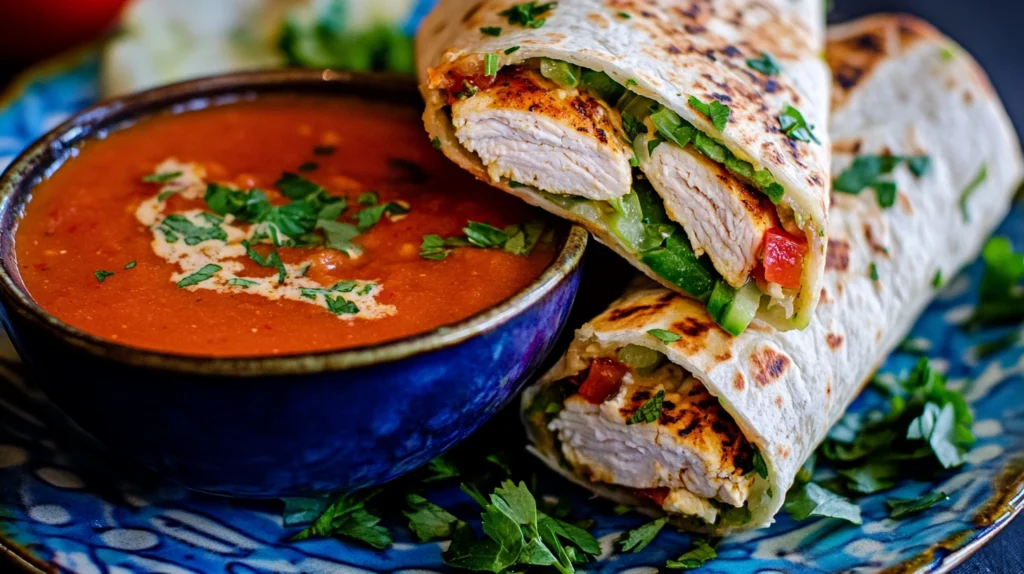
Gluten-Free Wraps
Create wraps using gluten-free tortillas or lettuce leaves.
- Filling Ideas: Grilled chicken, avocado, lettuce, and a drizzle of dairy-free dressing.
Lactose-Free Creamy Soups
Use coconut milk or cashew cream as a base for soups like tomato basil or potato leek.
- Example: Dairy-Free Tomato Soup
- Ingredients: Fresh tomatoes, onion, garlic, vegetable stock, and coconut milk.
- Instructions: Blend cooked ingredients until smooth and finish with a splash of coconut milk.
Hearty Grain Bowls
Combine gluten-free grains like quinoa or rice with roasted vegetables, chickpeas, and a tahini-based dressing for a nutritious and satisfying meal.
Delicious Dinner Recipes: Gluten-Free and Lactose-Free Options
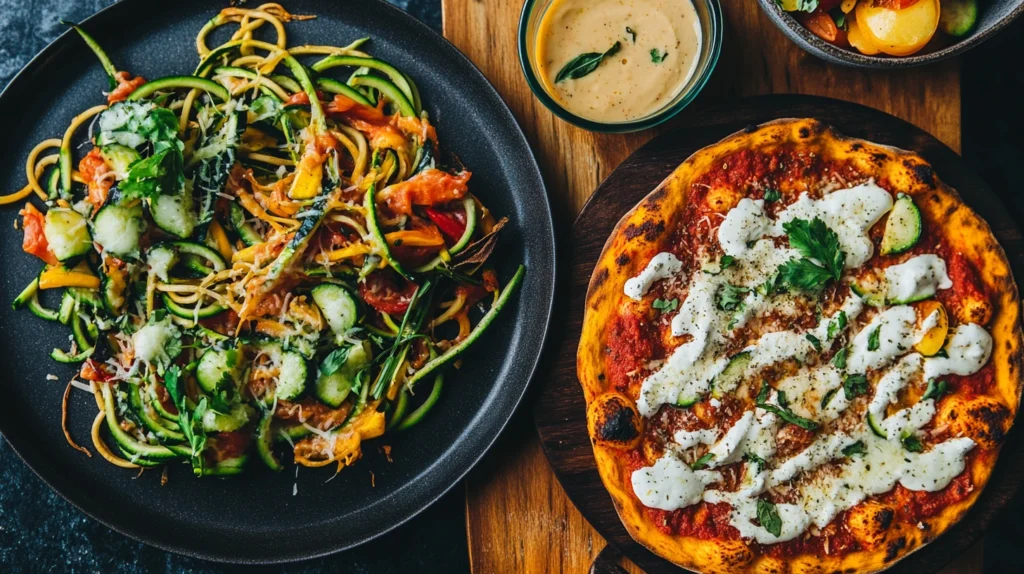
Zucchini Noodles with Vegan Cheese Sauce
Zucchini noodles, or “zoodles,” are a fantastic gluten-free alternative to pasta. Paired with a creamy vegan cheese sauce, this dish is light yet satisfying.
- Ingredients for Zoodles: 2 large zucchinis, olive oil, salt, and pepper.
- Ingredients for Vegan Cheese Sauce: 1 cup cashews (soaked), 2 tbsp nutritional yeast, 1 garlic clove, ½ cup almond milk, lemon juice, salt.
- Instructions:
- Spiralize the zucchinis to create noodles.
- Sauté zoodles lightly in olive oil until tender but firm.
- Blend the sauce ingredients until smooth.
- Toss the zoodles with the sauce and serve hot.
Gluten-Free Pizza
Making a gluten-free pizza crust at home is easier than it sounds!
- Crust Ingredients: 2 cups almond flour, 1 egg, 1 tbsp olive oil, ½ tsp salt.
- Toppings: Tomato sauce, lactose-free cheese, vegetables, and herbs.
- Instructions:
- Mix crust ingredients and shape into a circle on a parchment-lined baking sheet.
- Pre-bake the crust at 375°F (190°C) for 10 minutes.
- Add toppings and bake for an additional 10-15 minutes.
Lactose-Free Stir-Fry
This quick and easy dish can be customized with your favorite gluten-free ingredients.
- Ingredients: Gluten-free soy sauce, fresh vegetables (broccoli, carrots, bell peppers), tofu or chicken, sesame oil, ginger, garlic.
- Instructions:
- Heat sesame oil in a wok or pan.
- Sauté garlic and ginger, then add your protein choice.
- Toss in vegetables and stir-fry until tender.
- Add gluten-free soy sauce and serve over rice or quinoa.
Indulgent Gluten-Free and Lactose-Free Dessert Recipes
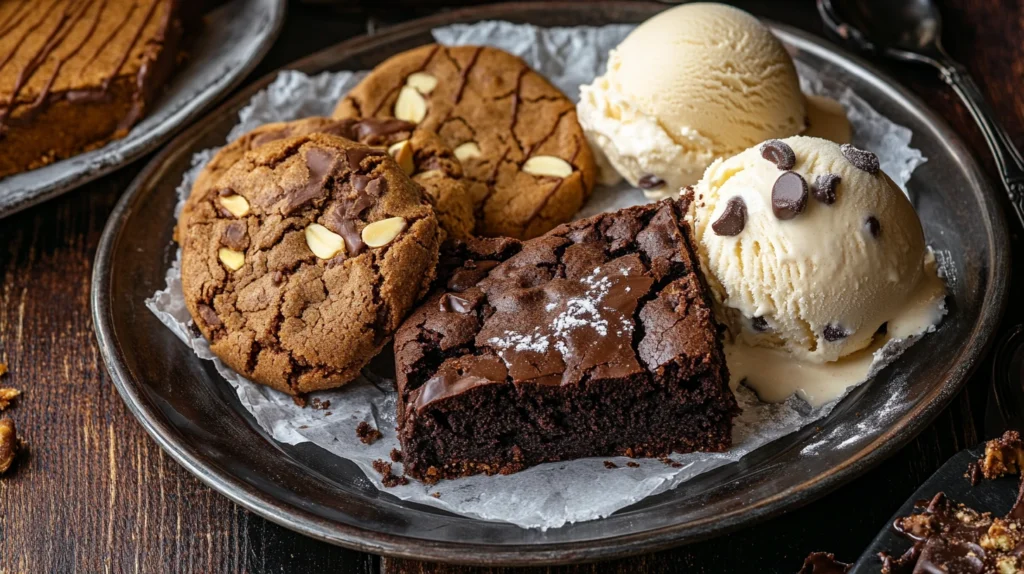
Almond Flour Cookies
These cookies are not only gluten-free but also lactose-free, making them perfect for everyone.
- Ingredients: 2 cups almond flour, ½ cup coconut sugar, 1 egg, 1 tsp vanilla extract, a pinch of salt.
- Instructions:
- Mix all ingredients in a bowl.
- Scoop dough onto a baking sheet and flatten slightly.
- Bake at 350°F (175°C) for 10-12 minutes.
Dairy-Free Ice Cream
No ice cream maker? No problem!
- Ingredients: 2 cans coconut milk, ½ cup maple syrup, 1 tsp vanilla extract, a pinch of salt.
- Instructions:
- Blend all ingredients until smooth.
- Freeze the mixture, stirring every 30 minutes until it reaches the desired consistency.
Gluten-Free Brownies
Rich and fudgy, these brownies are a crowd-pleaser.
- Ingredients: 1 cup almond butter, ½ cup cocoa powder, ½ cup coconut sugar, 2 eggs, 1 tsp vanilla extract.
- Instructions:
- Mix ingredients until smooth.
- Pour batter into a greased pan and bake at 350°F (175°C) for 20-25 minutes.
Tips for a Balanced Gluten-Free and Lactose-Free Diet
Incorporating Nutritional Variety
A gluten-free and lactose-free diet doesn’t mean sacrificing nutrients. Ensure you include:
- Proteins: Legumes, nuts, seeds, and lean meats.
- Healthy Fats: Avocados, olive oil, and coconut products.
- Carbohydrates: Sweet potatoes, gluten-free grains, and fruits.
Combining Ingredients Effectively
For example, pair plant-based proteins like quinoa and lentils with vegetables to create balanced meals. Use dairy alternatives like coconut yogurt or almond milk to ensure you’re getting sufficient calcium.
Smart Meal Prep for Gluten-Free and Lactose-Free Recipes
Preparing meals in advance is one of the best ways to maintain a gluten-free and lactose-free diet while saving time and reducing stress. Here are some practical tips and strategies:
Weekly Meal Prep Plan
- Plan Your Meals: Start with a menu for the week, including breakfasts, lunches, dinners, and snacks. Focus on simple recipes with overlapping ingredients to minimize costs and effort.
- Batch Cooking: Prepare large portions of gluten-free grains like quinoa or rice and store them in airtight containers for use in multiple meals.
- Pre-Cut Vegetables: Chop vegetables like carrots, bell peppers, and broccoli ahead of time for quick stir-fries or salads.
- Sauces and Dressings: Make lactose-free sauces (like coconut curry sauce or dairy-free pesto) and store them in jars to use throughout the week.
Storage Tips for Gluten-Free and Lactose-Free Recipes
- Glass Containers: Use BPA-free, airtight glass containers to keep prepped meals fresh.
- Labeling: Clearly label meals with the name and date to avoid confusion and waste.
- Freezing: Soups, stews, and baked goods freeze well and can be reheated for quick dinners.
Sample Meal Prep Schedule for Gluten-Free and Lactose-Free Recipes
- Sunday: Batch-cook quinoa, bake almond flour muffins, and prepare a big pot of dairy-free soup.
- Wednesday: Refresh the menu by roasting a tray of mixed vegetables and cooking a fresh gluten-free pasta dish.
- Friday: Make a dairy-free dessert like chia pudding or coconut ice cream for a weekend treat.
With a little preparation, sticking to a gluten-free and lactose-free diet becomes much more manageable.
Dining Out Safely with Gluten-Free and Lactose-Free Options
Navigating restaurant menus with dietary restrictions can be challenging, but it’s entirely possible with these tips:
Communicate Clearly
- To begin with, inform your server about your gluten-free and lactose-free needs. Use phrases like “I have a gluten allergy” to emphasize the importance of compliance.
- Ask specific questions about preparation methods, such as whether a dish contains wheat-based thickeners or dairy in the sauce.
Focus on Naturally Friendly Options
- Salads: Opt for salads with olive oil and vinegar dressings, avoiding croutons and creamy dressings unless verified.
- Grilled Proteins: Dishes like grilled chicken or fish paired with vegetables are typically safe bets.
- Gluten-Free and Vegan Menus: Many restaurants now offer dedicated menus for dietary needs. Always double-check ingredients, as cross-contamination can occur.
Apps and Resources
- Use apps like “Find Me Gluten Free” to locate restaurants with gluten-free options.
- Check reviews and menus online before dining to ensure they cater to lactose- and gluten-free diets.
By being proactive, dining out can remain an enjoyable experience even with dietary restrictions.
Top Brands for Gluten-Free and Lactose-Free Products
The growing demand for gluten-free and lactose-free products has led to a variety of reliable brands that make life easier. Here are some recommendations:
Gluten-Free Brands
- Bob’s Red Mill: Offers a range of gluten-free flours, baking mixes, and grains.
- Schär: Specializes in gluten-free bread, pasta, and snacks.
- Simple Mills: Known for gluten-free crackers and baking mixes.
Lactose-Free Brands
- Daiya: Provides lactose-free cheese, yogurt, and frozen desserts.
- So Delicious: Offers a variety of coconut milk-based products, including ice cream and creamers.
- Earth Balance: Makes lactose-free butter alternatives and spreads.
Combination-Friendly Brands
- Enjoy Life Foods: Produces snacks and baking ingredients that are free from major allergens, including gluten and dairy.
- Silk: Known for its plant-based milk options, including almond and soy milk.
These brands provide convenient solutions for stocking your pantry with safe and delicious alternatives.
Overcoming Challenges with Gluten-Free and Lactose-Free Diets
Adopting a gluten-free and lactose-free lifestyle comes with unique challenges. However, with some foresight and creativity, these obstacles can be effectively managed.
Hidden Sources of Gluten and Lactose
Many packaged foods have hidden gluten or lactose, even in items you might not expect. For instance:
- Hidden Gluten: Soy sauce, salad dressings, soups, and even some processed meats like sausages.
- Hidden Lactose: Certain bread, margarine, processed snacks, and medications.
Solution:
- Always check ingredient labels for keywords like “modified food starch” (a potential gluten source) and “whey” or “casein” (indicators of lactose).
- Familiarize yourself with certified gluten-free and lactose-free symbols on packaging.
Managing Cravings
Cravings for traditional bread, cheese, or desserts can make dietary restrictions feel overwhelming, especially in the early stages.
Solution:
- Find high-quality alternatives, such as almond flour bread or lactose-free cheese.
- Experiment with recipes that mimic traditional favorites.
Eating in Social Settings
Parties, potlucks, or family gatherings often lack options for restricted diets, leaving you feeling left out.
Solution:
- Offer to bring a dish to share that meets your dietary needs.
- Inform the host ahead of time about your restrictions, or eat a small meal before attending the event to avoid going hungry.
Cross-Contamination
Even small traces of gluten or lactose can cause reactions for some individuals, making cross-contamination a significant risk in shared kitchens or restaurants.
Solution:
- Use separate utensils, cutting boards, and toasters for gluten free and lactose free cooking.
- At restaurants, request that your meal is prepared in a clean area to avoid contamination.
By addressing these challenges proactively, you can maintain your dietary needs without feeling deprived or stressed.
Why Gluten-Free and Lactose-Free Recipes Are Good for You
Improved Digestive Health
Many people report fewer episodes of bloating, gas, and indigestion after removing gluten and lactose from their diets. This is particularly true for those with celiac disease, gluten sensitivity, or lactose intolerance.
Increased Energy Levels
Eliminating these ingredients can lead to more stable blood sugar levels and reduced inflammation, contributing to consistent energy throughout the day.
Reduced Inflammation
Both gluten and lactose can trigger inflammatory responses in sensitive individuals. Removing them can result in noticeable improvements in joint pain, skin conditions, and overall well-being.
Weight Management
For some, going gluten-free and lactose-free can support weight management. By focusing on whole, unprocessed foods and reducing sugar-laden snacks, it becomes easier to maintain a healthy weight.
Enhanced Skin Clarity
Many individuals notice clearer skin after removing lactose, as dairy products can sometimes contribute to acne and other skin issues.
FAQs About Gluten-Free and Lactose-Free Recipes
1.For instance, can I still enjoy desserts on a gluten-free and lactose-free diet?
Absolutely! There are countless recipes for desserts like almond flour cookies, coconut milk ice cream, and gluten-free brownies. Many natural sweeteners and plant-based alternatives are available.
2. How do I know if a product is truly gluten-free or lactose-free?
Look for certified labels such as “gluten free” or “dairy free” on the packaging. Additionally, read the ingredient list for any hidden gluten or dairy derivatives.
3. What are some easy snacks for a gluten-free and lactose-free lifestyle?
- Fresh fruit and nut butter.
- Gluten-free crackers with lactose free cheese.
- Roasted chickpeas or mixed nuts.
4. Is it expensive to follow this type of diet?
While specialty products can be costly, focusing on whole foods like fruits, vegetables, rice, and beans can, therefore, help keep costs down. Additionally, cooking at home significantly reduces expenses.
5. Can children follow a gluten-free and lactose-free diet safely?
Yes, but it’s essential to ensure they receive adequate nutrients. Consult a healthcare provider or dietitian to ensure their dietary needs are met.
6. How can I transition to this diet without feeling overwhelmed?
Start by swapping one meal or snack a day with gluten free and lactose free alternatives. Gradually expand your repertoire as you discover more recipes and brands.
Enjoy the Benefits of Gluten-Free and Lactose-Free Recipes
Living a gluten free and lactose free life style isn’t just about cutting out certain foods; instead, it’s a chance to try new cooking ideas and improve your health. It’s a chance to try new cooking ideas and improve your health. With ingredients like almond flour and coconut milk, you can create recipes that are both simple and delicious.
By planning meals ahead, tackling any challenges, and using helpful resources, you can succeed with this diet. Whether you’re managing food sensitivities or simply seeking healthy meal options, these recipes and tips will guide you in creating delicious and satisfying dishes every day.

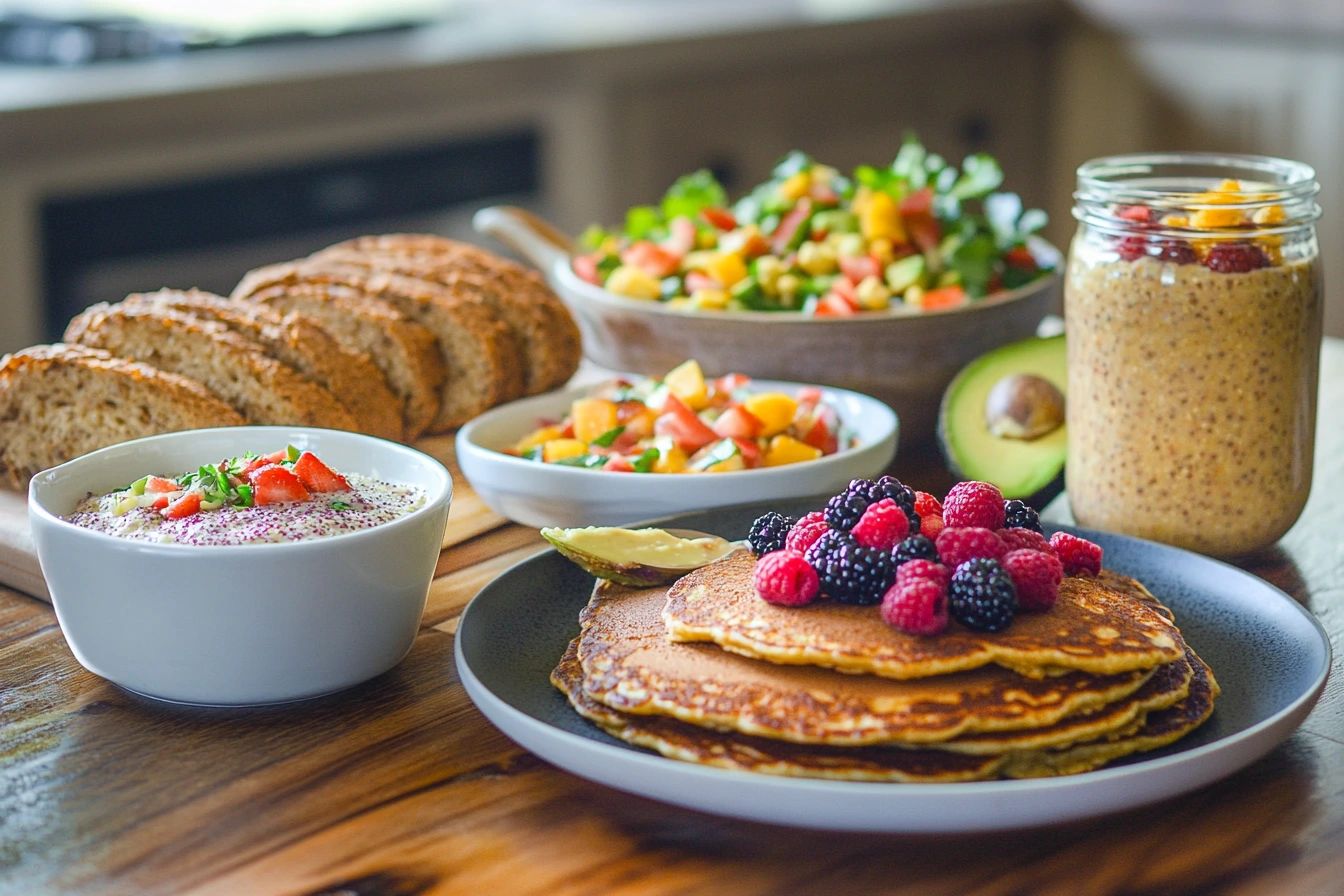
4 thoughts on “Gluten-Free and Lactose-Free Recipes: 25 Tasty Dishes to Try!”